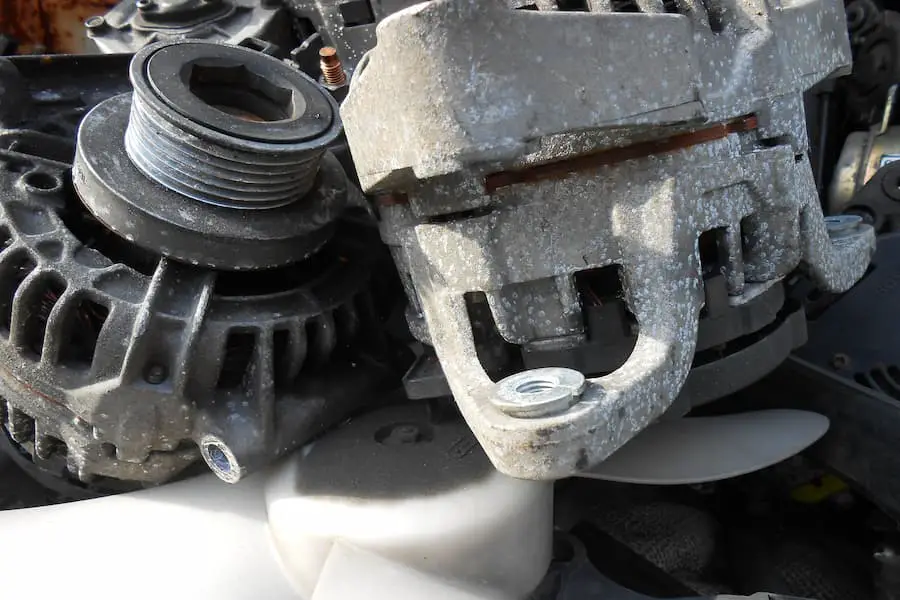As an Amazon Associate we earn from qualifying purchases.
Are you facing issues with your alternator and want to learn how to test an alternator by disconnecting the battery? We got you covered. This guide highlights the prominent reasons behind its damage and the step-by-step methods to do it in detail.
How To Test Alternator By Disconnecting Battery
Before we get into our major issue, it’s best if we take a look over the primary signs and symptoms of a failed alternator.

Signs Of Failing Alternator
If you’re a novice or new to the auto industry, determining which components are failing might be really challenging.
For example, if your car won’t start for no apparent reason, various features could be a problem.
A dead battery, a loose battery connection, a defective starter, a malfunctioning relay, or damaged alternators are all possible causes. With that in mind, let’s take a look at several indications that may indicate that your alternator is about to fail.
1.Twinkling Headlights
The first sign of a failed alternator is usually dimming headlights. The alternator, after all, is in charge of powering both the headlights and the dashboard lights. If you see your headlights fading while you accelerate your vehicle, it’s a sign that your alternator is malfunctioning.
2. Electrical Issues
Aside from the headlights and dashboard lighting, your car’s electrical system is another area that can indicate potential problems. This comprises the windshield wipers, power locks, power windows, heated seats, air conditioning system, radio, and other electrical components.
Because the alternator is in charge of powering all of these parts, there’s a potential that they’ll all start acting up.
3. Unusual Sounds
Grinding and screeching sounds are among the sounds you’re likely to hear. Because so many moving elements encircle the alternator, a single error in one of them might make odd noises similar to those produced by a worn-out bearing.
The voltage regulator may also transmit signals to the alternator, demanding extra charge at times. You may hear screeching sounds in the process as the alternator has already been worn out and unable to meet the high power requirements.
4. Caution Indicator
A warning light in the dashboard labeled GEN or ALT is another obvious clue that your alternator is in serious trouble. If you encounter this signal, it’s evident that your alternator needs to be evaluated right away.
5. Trouble Starting The Car
Trouble in starting the car is the final indication of a failed alternator. A dead battery is the most common cause of this symptom. When the battery dies, however, an unique light in the shape of a battery will show on your dashboard. At the very least, using this indicator, you can quickly rule out the battery as the main reason.
So, all that’s left is the alternator. Because this component is in charge of providing power to the spark plug, your automobile will either fail to start or stall while driving.

Why Alternator Fails?
The alternator can fall out of work overtime. Other factors, on the other hand, can cause premature wear.
Reason 1: Fluid Leakage
The alternator can get damaged if the power steering fluid or motor oil leaks upon it. Hence, regularly inspecting the unit for leaks and promptly repairing them is a simple approach to avoid this.
Reason 2: Unsafe Driving Practices
The alternator’s performance is influenced by how you drive. You put additional wear on the alternator if you spend more time idling the car with other tools and types of equipment left turned on. It will generate a lot of energy, which will lead the alternator to fail sooner rather than later.
Reason 3: Exposure to Moisture
The alternator is close to the engine and is susceptible to water damage. Both situations can cause premature alternator wear; regardless you reside in a humid locality with a lot of moisture or your device leaking fluids over the alternator.
Steps to Test Alternator by Disconnecting Battery
In this part, we will go through step-by-step ways you can test your alternator by disconnecting the battery.
Firstly, unplug the battery, and follow the steps stated below:
- Step 1: Finding a safe place to park your automobile is the first step in testing the alternator. To protect children, pets, and older citizens from harmful carbon monoxide build-up that can occur after unplugging the battery, it’s best to park in an open area away from them.
- Step 2: Next, open your car’s bonnet and ensure it’s properly positioned.
- Step 3: Before starting the engine, check the battery to make sure it’s in good working order. Examine the dashboard to see if the battery is transmitting any power even while the car is turned off. Turn on and off all electrical components, such as wipers, windows, brake lights, and the radio, to see if they’re working correctly. Finally, remove any corrosion from the battery terminals before checking the voltage using a voltmeter. The voltmeter value must be 12.6 V while the engine is not operating. The voltmeter value should be within 14 and 15 V when the engine is running.
- Step 4: Once you’ve finished, get into the driver’s seat and turn on the engine. This stage is difficult because your car may not start if the alternator is the problem. However, if the alternator is alright, the engine will most certainly start, even if it takes some time.
- Step 5: Now that we’ve ruled out the chance of a dead battery, we’re sure the issue is caused by a failed alternator. So, while the engine is still running, exit the vehicle and return to the bonnet. Disconnect the battery’s positive terminal to observe what occurs.
If the engine stops when you disconnect the battery terminal, the problem is most likely the alternator. However, if the engine continues to run after the battery has been disconnected, the alternator is in good working order.
Because the alternator is in charge of giving electrical energy to different components, a good alternator will continue to supply power to the engine even if the battery is detached. However, if the alternator is damaged, it will be unable to deliver power to the engine, causing it to turn off as soon as the battery is disconnected.
Why Should You Avoid Using This Method to Check for a Bad Alternator vs a Bad Battery?
The steps indicated above are straightforward. However, they are not recommended. Disconnecting the battery wire could not be simple, but it is also a dangerous action.
To begin with, the test may be unsuccessful. You risk killing the regulator by pulling the battery line to test an alternator.
Furthermore, the outcomes aren’t entirely trustworthy. Even if the alternator is on its way out, it can still drive the engine if it is producing some power. As a result, you can believe your alternator is in working well when it isn’t.

Conclusion
Since the above method is not highly recommended, what is a safer way to do it? To test an alternator more accurately, you can use a premium quality multimeter or an alternator battery tester.
This device will take readings with higher precision without harming the regulator of the vehicle.
